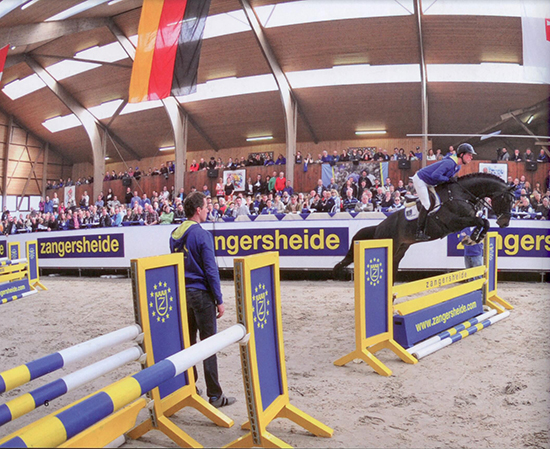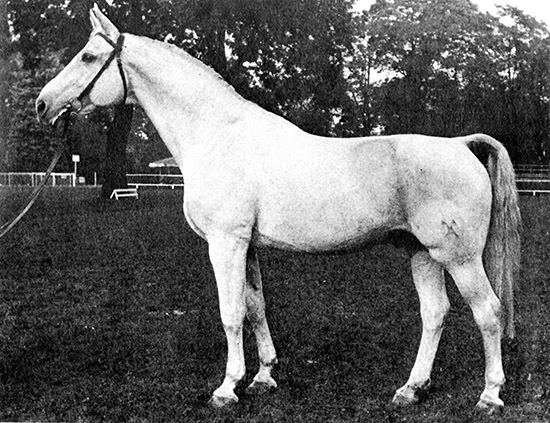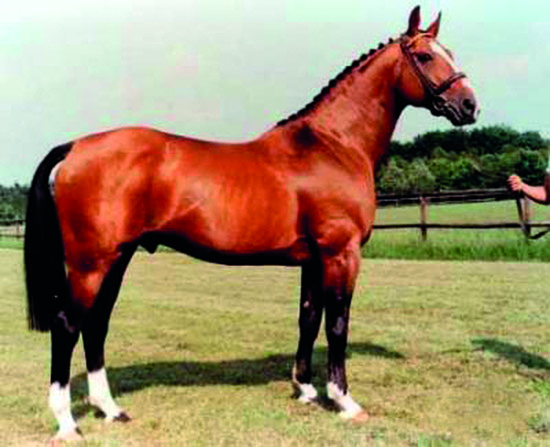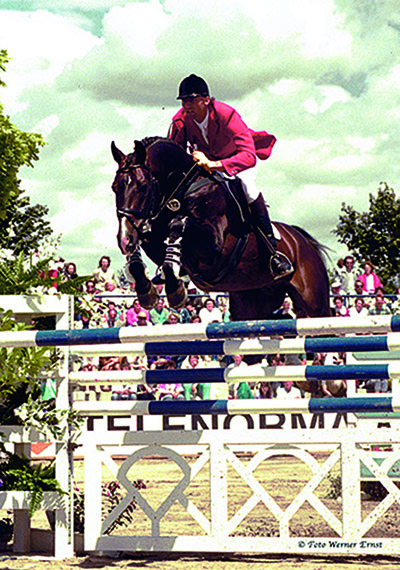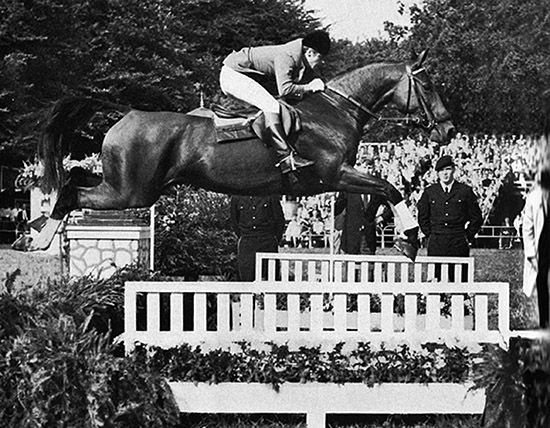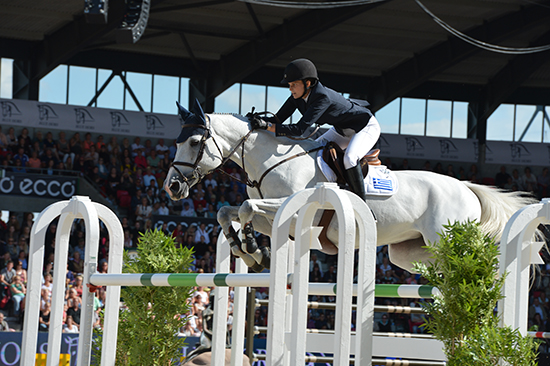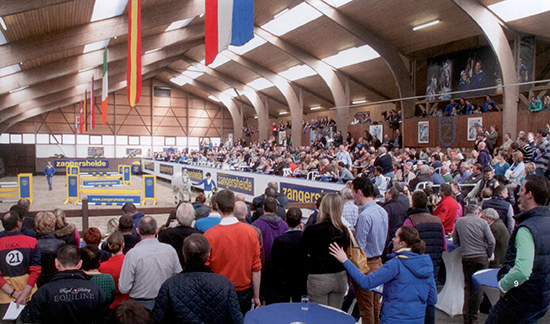Launched in 1992, the Zangersheide Studbook was fixed on one aim. According to founder, Leon Melchior, “We want to breed only jumping horses.”
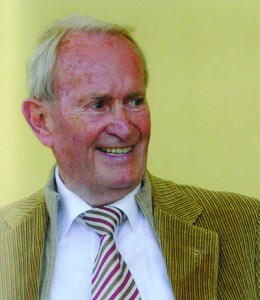 The new book came with a star-studded selection committee: Alwin Schockemöhle, Alain Navet and Reiner Klimke. And the names in the first Stud Book selection were fancy enough. Breeders had their choice of established stallions like Grandeur, Grannus and Lord Calando, or up-and-coming youngsters like Atlantus Z or Amadeus Z. In all there were 22 stallions in the initial Zangersheide Stud Book, mainly Holsteiner bred, with a few Hanoverians and one Russian pure bred Trakehner.
The new book came with a star-studded selection committee: Alwin Schockemöhle, Alain Navet and Reiner Klimke. And the names in the first Stud Book selection were fancy enough. Breeders had their choice of established stallions like Grandeur, Grannus and Lord Calando, or up-and-coming youngsters like Atlantus Z or Amadeus Z. In all there were 22 stallions in the initial Zangersheide Stud Book, mainly Holsteiner bred, with a few Hanoverians and one Russian pure bred Trakehner.
When I interviewed him, in 1993, Melchior was proud of the brood mare band he had built up at Zangersheide:
“The special breeding stock of mares that we have represents unequalled blood. But we have here on this property quality blood, you would never find it elsewhere, never, and we have to be very careful. You don’t see that many stallions here that we give a chance to breed. You never find a stallion here in the stables without a well known family and we believe in line breeding. We believe if we have a line of quality stallions, quality family, quality jumpers, then we believe that breeding is not only luck.”
“Now we have over one hundred and twenty stallions born on Zangersheide, breeding all around the world – and more than half do not use the ‘Z’ in the name – we don’t like that. In the same way, there are more than a hundred jumping horses around the world, competing in the highest classes but only a few use the Z with their name.”
(This is perhaps compensated by Mr Melchior’s policy of stamping a Z after the names of horses he has bought that have no prior connection with his breeding program. Sort of branding by cheque book…)
Melchior wanted to keep the rules of the new Stud Book simple: “The Stud Book Z intends to put up as few regulations as possible. You as a breeder and mare owner determine freely which stallion you use. We understand that you wish to breed jumpers and that your mare is bred on performance lines or that your mare has been proven in the sport or by breeding performers that she is ‘Z’ worthy. Zangersheide Stud has had certain experience, for example, with the mare Argentina (by Almé out of Heureka) who did not perform herself but became the main pillar of the Zangersheide breeding program. We intend to evaluate the broodmares according to the breeding value regulations as developed for the Z stallions. These breeding value assessments will be published.”
“Every year we will have a selection of foals, and after that we will have an auction, with a lot of international customers in attendance. We believe that the Z label is a quality label, and we believe that a lot of people will come to buy our young horses. We believe that the problem for the breeders is not to breed good horses, the problem most of the time is to find the right clients.”
By 2008, the Zangersheide Auction had grown to the stage where 31 foals reached an average price of euro 11,274 on the first night – not bad for an auction held as the world’s financial markets went into meltdown. The top price for fillies of euro 28,000 went for a foal by Cassini I. The top priced colt on the second night, by Levisto, sold for euro 41,000 and contributed to an average price of euro 13,064 for the 31 lots. Foals went all over the world, literally fro Azerbeidjan to Argentinia.
When Melchior commenced breeding, he registered his horses with the Hanoverian Verband, but eventually the dilution of the Hanoverian component brought about a split:
“It’s not with bad feeling that we left the Hanoverians, but every Stud Book has a lot of rules. The associations have great big books full of rules – it is not comfortable to read it. We want to breed for fun, we love it as a hobby and we don’t need a legal book before we can start to breed.”
You start with Gotthard, and then you add…
… Almé
“If you start in Hanover with the best level of jumping horse you can find, that means you start with Gotthard and horses like that, then you have to cover those mares with another good horse – so you go to a horse like Almé. Why? Because Almé is from France very far away from Hanover and you get the out-cross effect. The outcross effect means that if you have two or three breeds of dog, they are always more healthy if you cross them than if you keep line breeding the same breed of dog. If you cross two different horse lines then the result is stronger, healthier, more robust.”
“So that’s what we did with the next generation from Almé. If you cross the result with the best of the English Thoroughbred and the Arabian from Ramzes, that’s what we had in Ramiro – then we are once again crossing a completely different way – the out-cross effect again. Then with the results of breeding with Almé and Ramiro, we can cross them again without any danger at all – then you have the best results of inbreeding.”
“The bad way of in-breeding is when you have a small island, and for hundreds of years there is no new blood, then you have problems but not the way we have found to do it. But it is not a question of us finding out how to do it. If you go to the Agriculture industry, the breeders of chickens, or pigs – where they measure the number of eggs each chicken produces or the ability of the pig to gain weight, then it is easy to control and measure the success of your breeding program. With horses it is much more difficult but the idea is exactly the same. The agricultural industry has followed exactly the same breeding program – starting with very different breeds of chickens or pigs, then they bring it together and they have a new breed.”
“If you take a very old fashioned type of Warmblood horse, and breed it to a fullblood, a Thoroughbred horse, most of the time the result is very useful. You have the power of the old fashioned line, and the flexibility and speed from the full blood. But if you go further, trying to do that cross you can run into problems. If you do what we are doing, then you have a basic line from Hanover the best of the best, selected and selected – then you take the best of France – Almé then you take the best of the Thoroughbred and the Arabian – Ramiro – then you have the best of the best, the same line, and it is not a gamble, you know what you are getting.”
Will there be a point in future when you will have to find another bloodline to introduce to keep the vigour of your line of horses?
“The problem is that it is very hard to find them. That is why we have the horse Almox Prints, the Russian Trakehner. That is also a completely separate line, and with that outside blood we try to establish another line, then after three or four generations, we come back to Almé or Ramiro. We still have eighteen portions of Almé and Ramiro frozen semen.”
Almox Prints – the Russian Trakehner
How did you start to breed horses?
“The first time I started to ride was when I was thirty seven years old. I had some very good horses, and my favorite was the mare, Heureka. Ridden by Herman Schridde she won the Grand Prix of Aachen. You can understand what a good horse she was, but at that time the courses were not so difficult, the courses were not so related, the quality of the horses and riders was not so high. Nowadays all the standards are higher, and the course builders are much better. Before it was always higher and higher and higher and that is not an honest test of a good horse.”
Heureka – the mare that started it all..
“Heureka was one of my favorite horses and when we started to breed with her, every one was giving me different advice, and I started reading and talking with Agricultural breeders – the breeders of chickens, pigs, everything. They know everything, they are computerised, they can show you real inbreeding. What we are doing is not inbreeding. There are people who are writing about ‘inbreeding’ in the horse world, and they don’t know what inbreeding is.”
“I believe that if you have a horse like Heureka, the best of the best of the best, and then you breed with her and the results are not good, you do something. We tried a few stallions, then after the study, we tried another way, a way that was more objective. It’s not that we don’t love horses, we are lovers of horses, we do the best of the best for the horses, but you need an objective approach to breeding.”
“In everything you do, you need feeling – but the foundation of what you do must be based on strict rules that you can find in the commercial agricultural breeding industry. Don’t make their mistakes, take only the best of their advice because after all a chicken is not a horse.”
“So we started thinking, how to build up a stud. How to find a basis. We made a graph to find out which family was most successful in Germany. At that time it was Hanover – not now but then – and then we looked for the best lines in Hanover, and then we looked to see at what age they did it, to find out if they were able to survive in the sport. So we found the lines for our basis. The outcross principle was already accepted. That is why we found Almé, then we found Ramiro – and they were the founders of this circle.”
Was Almé already winning?
“He was five years old and already exceptional. I rode him, I jumped him. Almé was one of the most exceptional stallions I ever saw. Ramiro was the same. He was older when we found him, he was not only a good jumping horse but he had already sired good horses.”
“So now we had three outcrosses, all the outcrosses we needed, now we can let them go together. The principles were simple. If you wanted to breed a pig which was ten kilos bigger, this is how they went. So why not the same with the jumping horses – why not take the gamble out. So we have Ratina, Ratina has a daughter who is by Cor de la Bryère, but when Ratina’s daughter had a foal, Hanover did not want to put the brand on this foal, that stops everything. It’s our money, our risk, our knowledge – we know more about breeding than people sitting behind desks.”
“The problem with several Stud Books is that there are a lot of people sitting there who make the rules and who run the organization, but they don’t have their own mares, they have never bought or sold horses, they don’t know how difficult it is. So we have founded our Stud Book, and we find people around us with the same problems as we had before. We find the best way is to accept the French stallions in Germany, accept the German stallions in France, mix them up and you have better horses, healthier horses, stronger horses.”
“One of the big problems is raising the horses. When the foal leaves its mother, it goes into a big stable with ten, twenty or thirty other horses, all in together. Every time they put new straw down, the bed of the stable gets higher and higher, and sometimes the weather is very bad and the horses are kept inside for weeks and weeks – the ammonia in the urine of the horses is poison to the lungs, and can cause lung problems. We always say to people, make the stables as open as possible, cold is not a problem – but there is nothing so terrible as ammonia.”
“The second thing that we have found is that if horses are standing too long, the veins, the hair line veins in the foot do not develop. We have one horse that had an accident and he had one month’s rest in the stable, and he was walking like a lady with high heels. We thought the horse was finished. We took x-rays and we saw that there were hardly any veins – we used contrast liquid in the veins and saw that there was a very small percentage of blood that was getting through. So we put this horse on the walking machine, and after two months he was walking as well as any horse we had. Once again we used the contrast liquid, and we saw now where there had been nothing before, that there was a cloud of hair veins.”
“If you have a horse and he is standing still all the time, he will not have enough veins. That is why we bought the walking machine that can take ten horses at the one time. We put our breeding mares on the machine so they get the exercise, and then when you have a mare like Ratina, after they have a foal they can come back into the sport very quickly…”
Certainly, the set-up in which the horses are bred is impressive. There are stables for over 300 horses although no one seems to know the precise number. One of the better stories that circulates about the charismatic Mr Melchior is his alleged reply to the journalist who asked him how many stallions he owned ‘”I don’t know,” he is supposed to have said, “and if I don’t know, nobody does.”
Mr Melchior’s stud at Lanaken, has also become very much the home for the World Young Horse Jumping Championships, which are held there every year…
Melchior prides himself at being at the cutting edge of breeding, and even in his 82nd year, hailed yet another Z development – cloning. In the editorial in the August 2008 Z Magazine he hails the birth of Chellano II Z, clone from Chellano Z, born on 25 July 2008:
“You may remember that Chellano Z, in the prime of life, with super prospects to a successful sport career, broke a leg and had to leave us. The offspring of this too early deceased stallion are doing exceptionally well in the sport. Is it not wonderful that, in this day and age, we have now a copy of such a promising stallion? Would we not be grateful if we could also have a clone of our other early deceased stallion, Caretano Z, who, like his offspring, was an uncommonly good performer.”
“It is particularly in view of stallions of this kind, themselves successful in the showjumping sport, and in addition, having demonstrated their ability to pass their sport qualities on, that the cloning technique was developed. A true blessing, this invention that prevents valuable genes being lost forever.”
And Zangersheide is in the lead when it comes to the new technique:
“Clones are still a delicate subject – ‘cloning’ is a thing only discussed in low tones. It was just the same, not so long ago, with AI, techniques which Zangershiede helped to develop, the freezing of sperm, dilutants, and resulting developments, such as endoscopic fertilization and embryo transplantation. All these things did at first elicit negative criticism. Now, you do not hear anybody speak about these things in negative terms, on the contrary, everyone is making a living from them and, perhaps, no longer remembers the part played by Zangersheide. So the ill feeings towards cloning will gradually disappear as well. Do not forget that cloning, if only because it is very expensive, will never become standard procedure.”
The same issue of the magazine, records that foal registrations at Zangersheide have increased by 30% in that year: “Z-breeders know why. An open market stragey with equal chances simple offers a better guarantee for success. That is what attracts the breeders. The ‘Z’ label has acquired a solid status, one with which an ever growing number of breeders want to be identified with. This is not least due to the offer of stallions and to the breeders’ joint objective to breed the best showjumping horse, irrespective of the breed or nationality. Another strong trump card of ‘Z’ are the logistic support and services offered in the marketing of the foals. Without restrictions, without protectionism.”
Now in his 87th year, Mr Melchior in the February / March 2014 issue of Z Magazine, celebrates the vigor of the studbook he founded:
Zangersheide is a studbook in action and in order to stay active, you need young legs. That is why we are rejuvenating our studbook and only attracted ‘young legs’. And boy, they are active!
So far, the internationalism of Zangersheide was mainly conducted from Lanaken. Thanks to new communication technologies, today it only needs a click to register your foal, from wherever in the world. That , too, seems a logical step in a united Europe and a globalized world. Still, it is often a battle against rust. Fortunately, young legs are not discouraged by this. If we can not arrange something from Lanaken, we will organize it on location. Until this very day Z-France is discriminated, fortunately not by the French breeders who received us with open arms in Deauville. Our first stallion selection outside Lanaken was a blessing for free thinking French breeders who want to throw off the yoke of the state studfarms. (Seemingly no one has told Mr Melchior that this state studfarms are now devoid of stallions) Our Z-stallions were received with spontaneous applause. The warm welcome from the French breeders has motivated us to shift our borders, to take action and to go on tour. France was the first lap of the long walk, the first stage of a journey around the world. Zangersheide is in action, it dares to make a leap and in the long run every breeder will profit from this.
In November 2014, Z Magazine signalled the end of an era:
“‘Captain’ Leon Melchior does not abandon the ship, but he leaves the bridge. Leon Melchior feels that the time is ripe to definitively hand over the reins of Zangersheide to his daughter, Judy Ann Melchior. From now on she will handle the daily management of Zangersheide. In but a few decades, Studfarm and Studbook Zangersheide developed into world-famous institutions and quality labels in the world of sport and breeding… In the story of Zangersheide only the prologue has been written so far. Leon Melchior made the first move and paved the way and Judy Ann will now follow and continue that path unabated and stolid, in the spirit and philosophy of Zangersheide.”
There were six representatives of Studbook Zangersheide at the WEG in 2014 – including AD Camille Z (Cumano / Clinton) with Athina Onassis-de Miranda

